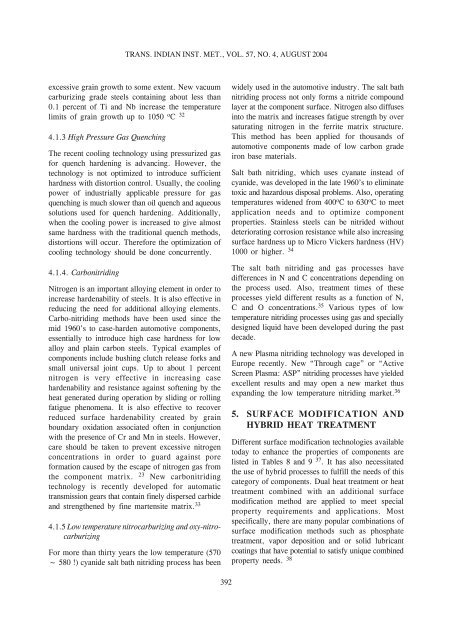HEAT TREATMENT OF AUTOMOTIVE COMPONENTS: CURRENT ...
HEAT TREATMENT OF AUTOMOTIVE COMPONENTS: CURRENT ...
HEAT TREATMENT OF AUTOMOTIVE COMPONENTS: CURRENT ...
Create successful ePaper yourself
Turn your PDF publications into a flip-book with our unique Google optimized e-Paper software.
TRANS. INDIAN INST. MET., VOL. 57, NO. 4, AUGUST 2004<br />
excessive grain growth to some extent. New vacuum<br />
carburizing grade steels containing about less than<br />
0.1 percent of Ti and Nb increase the temperature<br />
limits of grain growth up to 1050 o C 32<br />
4.1.3 High Pressure Gas Quenching<br />
The recent cooling technology using pressurized gas<br />
for quench hardening is advancing. However, the<br />
technology is not optimized to introduce sufficient<br />
hardness with distortion control. Usually, the cooling<br />
power of industrially applicable pressure for gas<br />
quenching is much slower than oil quench and aqueous<br />
solutions used for quench hardening. Additionally,<br />
when the cooling power is increased to give almost<br />
same hardness with the traditional quench methods,<br />
distortions will occur. Therefore the optimization of<br />
cooling technology should be done concurrently.<br />
4.1.4. Carbonitriding<br />
Nitrogen is an important alloying element in order to<br />
increase hardenability of steels. It is also effective in<br />
reducing the need for additional alloying elements.<br />
Carbo-nitriding methods have been used since the<br />
mid 1960’s to case-harden automotive components,<br />
essentially to introduce high case hardness for low<br />
alloy and plain carbon steels. Typical examples of<br />
components include bushing clutch release forks and<br />
small universal joint cups. Up to about 1 percent<br />
nitrogen is very effective in increasing case<br />
hardenability and resistance against softening by the<br />
heat generated during operation by sliding or rolling<br />
fatigue phenomena. It is also effective to recover<br />
reduced surface hardenability created by grain<br />
boundary oxidation associated often in conjunction<br />
with the presence of Cr and Mn in steels. However,<br />
care should be taken to prevent excessive nitrogen<br />
concentrations in order to guard against pore<br />
formation caused by the escape of nitrogen gas from<br />
the component matrix. 23 New carbonitriding<br />
technology is recently developed for automatic<br />
transmission gears that contain finely dispersed carbide<br />
and strengthened by fine martensite matrix. 33<br />
4.1.5 Low temperature nitrocarburizing and oxy-nitrocarburizing<br />
For more than thirty years the low temperature (570<br />
~ 580 !) cyanide salt bath nitriding process has been<br />
widely used in the automotive industry. The salt bath<br />
nitriding process not only forms a nitride compound<br />
layer at the component surface. Nitrogen also diffuses<br />
into the matrix and increases fatigue strength by over<br />
saturating nitrogen in the ferrite matrix structure.<br />
This method has been applied for thousands of<br />
automotive components made of low carbon grade<br />
iron base materials.<br />
Salt bath nitriding, which uses cyanate instead of<br />
cyanide, was developed in the late 1960’s to eliminate<br />
toxic and hazardous disposal problems. Also, operating<br />
temperatures widened from 400 o C to 630 o C to meet<br />
application needs and to optimize component<br />
properties. Stainless steels can be nitrided without<br />
deteriorating corrosion resistance while also increasing<br />
surface hardness up to Micro Vickers hardness (HV)<br />
1000 or higher. 34<br />
The salt bath nitriding and gas processes have<br />
differences in N and C concentrations depending on<br />
the process used. Also, treatment times of these<br />
processes yield different results as a function of N,<br />
C and O concentrations. 35 Various types of low<br />
temperature nitriding processes using gas and specially<br />
designed liquid have been developed during the past<br />
decade.<br />
A new Plasma nitriding technology was developed in<br />
Europe recently. New “Through cage” or “Active<br />
Screen Plasma: ASP” nitriding processes have yielded<br />
excellent results and may open a new market thus<br />
expanding the low temperature nitriding market. 36<br />
5. SURFACE MODIFICATION AND<br />
HYBRID <strong>HEAT</strong> <strong>TREATMENT</strong><br />
Different surface modification technologies available<br />
today to enhance the properties of components are<br />
listed in Tables 8 and 9 37 . It has also necessitated<br />
the use of hybrid processes to fulfill the needs of this<br />
category of components. Dual heat treatment or heat<br />
treatment combined with an additional surface<br />
modification method are applied to meet special<br />
property requirements and applications. Most<br />
specifically, there are many popular combinations of<br />
surface modification methods such as phosphate<br />
treatment, vapor deposition and or solid lubricant<br />
coatings that have potential to satisfy unique combined<br />
property needs. 38<br />
392
















